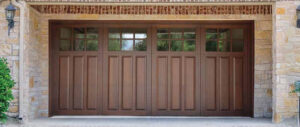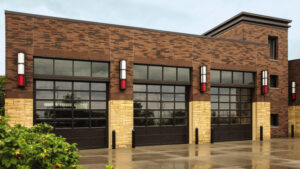When it comes to garage doors, one of the most important components is the torsion spring. If you’ve ever had a garage door that wouldn’t open or close properly, chances are the problem was related to a worn or broken torsion spring. Understanding how torsion springs work and why they’re a better option than other types of springs can help you make informed decisions about your garage door system.
A properly functioning garage door is not only convenient but also essential for home security. A broken spring can leave your garage door stuck open, making it vulnerable to intruders or exposing your vehicle and belongings to the elements. To keep your home safe and your garage door operating smoothly, let’s explore everything you need to know about garage door torsion springs.
What Is a Torsion Spring?
A torsion spring is a tightly wound coil made of strong metal that helps counterbalance the weight of your garage door. It stores mechanical energy as it twists and releases that energy when the door moves. This controlled motion makes the opening and closing process smooth and efficient.
Unlike extension springs, which stretch and contract along the sides of the door, garage door torsion springs are mounted above the door on a metal shaft. This central placement improves stability and longevity, making them a popular choice for homeowners and businesses alike.
Torsion springs are available in various sizes and strengths, depending on the weight and design of the garage door. Heavier doors require stronger springs with a higher cycle rating, while lighter doors can function with smaller, less rigid springs. Regardless of the size, all torsion springs operate on the same basic principle of storing and releasing energy to facilitate smooth door movement.
How Do Torsion Springs Work?
Torsion springs function by twisting as the garage door moves. Here’s how:
- When the door closes – The torsion spring winds up tightly, storing energy.
- When the door opens – The stored energy is released, helping to lift the door effortlessly.
This method of operation ensures a smooth and controlled movement, preventing sudden jerks or imbalances that can occur with other types of springs.
Unlike extension springs, which can create a bouncy, unpredictable motion, torsion springs provide a steady and reliable lift. This makes them ideal for garage doors of all sizes, from small residential doors to large industrial garage doors.
Why Are Torsion Springs Better Than Extension Springs?
Many older garage doors use extension springs, which work by stretching and contracting as the door moves. However, torsion springs offer significant advantages, making them the safer and more efficient option:
- Increased Safety: Torsion springs are mounted on a metal shaft, reducing the risk of them snapping and flying off, which can be dangerous. Extension springs, on the other hand, can break under tension and cause injuries or property damage.
- Longer Lifespan: Torsion springs typically last between 15,000 and 20,000 cycles, while extension springs wear out much faster, often lasting only 10,000 cycles or less.
- Smooth and Balanced Operation: Because they distribute force more evenly, torsion springs prevent the jerky movements common with extension springs, reducing strain on the garage door opener.
- Less Maintenance: With fewer moving parts and controlled operation, torsion springs require less frequent maintenance compared to extension springs.
- Quieter Performance: Torsion springs reduce noise during garage door operation, making them ideal for attached garages where noise levels matter.
For these reasons, most modern garage doors come equipped with torsion springs rather than extension springs. If your current system still uses extension springs, consider upgrading to a torsion spring system for improved safety and efficiency.
Signs Your Torsion Spring Needs Replacement
Over time, even the best torsion springs wear out. Here are some signs that it might be time for a replacement:
- The garage door won’t open or close properly
- You hear loud snapping or grinding noises
- The door feels heavier than usual
- Visible gaps in the torsion spring
- The garage door opens unevenly or too quickly
Ignoring these warning signs can lead to sudden spring failure, which can leave your garage door stuck in place. A broken torsion spring can also put extra strain on the garage door opener, leading to premature motor failure.
How Long Do Torsion Springs Last?
Torsion springs are rated by the number of cycles they can perform before wearing out. A single cycle consists of one complete opening and closing of the garage door. The average lifespan of a torsion spring is:
- Standard springs: 15,000 to 20,000 cycles
- High-cycle springs: 30,000 cycles or more
The more frequently you use your garage door, the sooner the spring will wear out. For example, if you open and close your garage door four times a day, a 20,000-cycle spring could last around 13 years. However, if your household uses the garage door frequently, it may wear out much sooner.
Can You Replace a Torsion Spring Yourself?
While some DIY projects around the house are manageable, replacing a garage door torsion spring is not one of them. These springs are under extreme tension and can be very dangerous to handle without the proper tools and experience. A professional technician has the right skills to safely replace the spring and ensure your garage door operates correctly.
Attempting a DIY torsion spring replacement can lead to serious injury, as the tightly wound spring can snap with immense force. It’s always best to call a trained technician who has the proper equipment and expertise to handle the job safely.
Torsion Spring Maintenance Tips
While you can’t prevent eventual wear and tear, you can extend the life of your torsion spring with proper maintenance. Here are some tips to keep your garage door running smoothly:
- Lubricate the spring: Apply a garage door lubricant every few months to reduce friction and prevent rust.
- Inspect for wear: Check the spring for visible signs of damage, such as cracks, rust, or gaps.
- Test the balance: Disconnect the garage door opener and manually lift the door halfway. If it doesn’t stay in place, the spring may be wearing out.
- Avoid excessive weight: Don’t hang heavy objects on your garage door, as added weight puts extra strain on the spring.
Regular maintenance can help delay the need for a costly spring replacement and keep your garage door functioning properly for years to come.
Do All Garage Doors Have Torsion Springs?
No, not all garage doors have torsion springs. While torsion springs are the most common type used in modern garage doors due to their durability and safety, some garage doors still use extension springs. Extension springs are mounted along the sides of the garage door and stretch to provide lifting force, whereas torsion springs are mounted above the door and use a twisting motion to balance and lift the door. If you’re unsure what type of spring your garage door has, a quick visual inspection can help, or you can consult a professional garage door technician.
What Is the Difference Between a Torsion Spring and a Tension Spring?
The primary difference between a torsion spring and a tension spring (often referred to as an extension spring) is how they store and release energy:
Torsion Spring: Uses twisting force to store mechanical energy. It is mounted above the garage door and unwinds to lift the door smoothly and evenly.
Tension (Extension) Spring: Stretches and contracts to create tension, helping to lift the garage door. These springs are installed along the sides of the door and expand when the door is closed.
Torsion springs are generally preferred because they last longer, provide smoother operation, and are safer compared to extension springs, which can snap under tension and cause serious injury or damage.
How Much Does It Cost to Replace a Torsion Spring?
The cost to replace a garage door torsion spring varies depending on several factors, including the type of spring, the size of the garage door, and labor costs in your area. On average, here’s what you can expect:
Single torsion spring replacement: $150 – $350 (including labor)
Double torsion spring replacement: $200 – $500 (including labor)
High-cycle or specialty torsion springs: $300 – $600
These prices include both the cost of the new spring and professional installation. Attempting to replace a torsion spring yourself can be dangerous due to the high tension involved, so it’s always recommended to hire a professional.
What Happens If a Torsion Spring Is Broken?
If a torsion spring breaks, your garage door will likely become difficult or impossible to open. Here’s what you can expect:
The door won’t open: A broken torsion spring means there’s no counterbalance to lift the door, making it feel extremely heavy.
You may hear a loud snapping sound: When a torsion spring breaks, it can release a significant amount of stored energy, often resulting in a loud bang.
The door might open unevenly or get stuck: If you have a dual-spring system and only one breaks, the door may open unevenly or at an angle.
The garage door opener may strain or fail: Without a functioning torsion spring, your automatic opener will struggle to lift the door and may burn out.
If your torsion spring is broken, do not attempt to use the garage door or manually lift it. Contact a professional technician immediately for a safe and proper replacement.
Keep Your Garage Door Running Smoothly
Your garage door torsion spring plays a vital role in the functionality of your door. Choosing the right spring and keeping it well-maintained can extend the life of your garage door system while keeping it safe to use.
If you suspect an issue with your torsion spring, don’t wait! Contact OHD Bellingham today at (360) 734-5960 for expert garage door repair and replacement services! Whether you need a new torsion spring, routine maintenance, or a full garage door upgrade, our team is here to help. Call now and ensure your garage door operates safely and efficiently!





